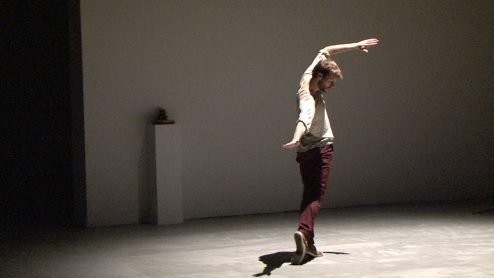Aporia signifie : sans moyens, sans ressources, privation, dénuement, indigence,
questionnement, contradiction logique, incertitude, embarras, étonnement, état en
suspension, difficulté de traverser, l’infranchissable, l’impénétrable.
Aporia, cet ébranlement des certitudes instituées et des évidences quotidiennes,
devient ainsi un élément indispensable à toute création philosophique et artistique, à
toute démarche qui interroge ses propres présupposés et fondements. Il s’agit ainsi de
voir double et de se voir double, de distance, comme sur une scène de théâtre.
Avec:
Critics
Distance/Detachment/Loss Detachment creates monsters. As does every encounter. Different monsters in each case, but of the same blood and essence. Monsters of our kind, and of our blood. But the most terrible is the in-between. In between the two, the « here » and « there », the « I » and « you ». This is what I felt that night with your « dance episode », Aporia. The event was double. One inside and one outside. I was in between. You took on the biggest challenge. You encountered your opposite. You gave movement, body, rhythm to a life in search of them and you accomplished this in the same moment that outside – at its furthest point, not of fire but of a glacial cold – some were fighting in favour of death. Inside, a rose-hued purity, such as only dawn offers; outside, a black decay with all the smells and tastes of corruption. This is what was happening that night. For me, the contrast was shocking, revealing, symbolic, comprehensive and succinct. It meant everything. It would not have meant anything had it been different; if, for instance, one of its two terms were missing, if something else were there instead of you. Your being there was the event of the evening. Your presence together with this devastating exterior, with this image of the end, gave to your breath the dimension of a re-naissance, not a re of repetition but of something about to be born, so what is it? It moves without shape, looking for its form, a process of an obvious and explorative gestation, as is every movement looking for the vital centre. A centre of life. A centre where life can be what it is not. An explorative dance that revokes dance, that re-establishes it at the level of words and thought, elevating thought to the status of a text written with the limbs, inscribed by whispers and sighs. I left crossing a landscape of death. Young people in the service of the final state of decomposition. Drowned in the unconsciousness of a funeral rite. After a while, the colours of dawn prevailed. And then, I said: I am alive.
Dimitris Dimitriadis 18. 5. 2014
Source: http://www.kraniotis.com/images/Ludwig/Dimitris-Dimitriadis_la-distance_gr_eng_fr_.pdf
I went twice to the Athens School of Fine Arts to see “Aporia”, a dance episode of the Collective Ludwig. Just before the performances I discussed with the collective on the Third Program of the National Radio. A magical work. The sound design created by Christine Kono was captivating in the impressive exhibition hall. The stage and light design of Paolo Rudelli were unique. I admired the choreography and dance of Christine Kono, Dimitris Kraniotis, Stephane Vernier, Liz Waterhouse. Both times I left enchanted. I was transported into another world, even further away than the one I have been living in for years.
Giorgos Chronas Odos Panos, no.163
Source: http://www.kraniotis.com/images/Ludwig/Chronas-final.pdf
Aπορία, temine intriso di storico valore culturale, originario della fiorente Atene in età Classica. Percorre i secoli e giunge a noi intonso, conservando in sé la propria etimologia filosofica ed è nella sua terra natia che la ricerca artistica di Collective Ludwig dà espressione della sua essenza. Esposizione. Installazione. Performance. Tutto raccolto e raccordato in una sinestetica Opera Performativa, allestita nello spazio espositivo dell’Accademia di Belle Arti di Atene, ideata, realizzata ed interpretata da preziosi artisti che hanno vissuto e fatto la storia della cultura artistica contemporanea.
Un non-luogo è ciò che viene offerto agli osservatori, non mostrato, bensì presentato per essere esperito e scoperto in un proprio percorso individuale. L’invito è aperto, si varca l’ingresso ed un’atmosfera eterea, densa di lieve fermento empatico aleggia nel vasto e arioso spazio, un tempo spoglio, asettico, gelido e che ora vive di una ricercata, poetica ed accogliente composizione installativa. Sedie lignee si stagliano, come in un fermo immagine nella loro evoluzione in un ordine entropico, nel paesaggio: circa cinquanta sedute ruotate, inclinate, accostate le une alle altre, segni di presenze vitali come tracce di un passaggio colte in una tranche sceno-coreografica. Luci soffuse tagliano squarci nel buio informe, rivelando visioni prospettiche che esaltano la bellezza della sensuale opera espressionista di Yannis Tsarouchis e del meraviglioso ventaglio da lui decorato, della stilizzazione surrealista di Pavlos Samios, degli acquerelli naïf di Giorgos Stathopoulos, degli schizzi delicati di Marinos Christakopoulos, della tela hopperiana di Yannis Zikas, intrinse di memoria storica ed artistica: sorgenti luminose come raggi solari o lunari illuminano terre neutre deleuziane, che dialogano elegantemente tra loro legate da minuziosi dettagli in un continuum di rimandi visivi, sonori e sensoriali, ove la libertà di percezione definisce il valore empatico dell’allestimento.
Continue on the original article
.
